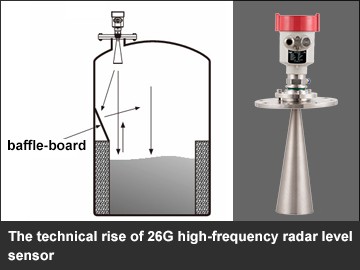The technical rise of 26G high-frequency radar level sensor
With the continuous growth of the national economy and the rapid development of industrial production. 26G high-frequency radar level sensor is widely used in industrial production process. Mainly because of the continuous improvement of the technical requirements of the level meter, the radar level sensor has been continuously developed from low-frequency radar to high-frequency radar.
A few months ago, the development of a new 26G high-frequency radar level sensor HR264 has got a great success. The 26G transmission frequency of the sensor is 3 to 4 times higher than the transmission frequency of the traditional low-frequency radar level meter. The 26GHz radar has a wavelength of 11mm and the low-frequency 6.3GHz radar has a wavelength of 50mm. When the radar measures the bulk material level, the radar wave reflection mainly comes from the diffuse reflection of the material surface. The intensity of the diffuse reflection is proportional to the size of the material and inversely proportional to the wavelength, and most of the bulk The feed straight is far less than 50mm. Since the launch of the 26GHz radar, more than 10,000 pieces have been installed for the measurement of bulk materials. The successful launch of this product has proved their value.
At the same time, the 26G high-frequency radar level sensor has high energy and a small beam angle (general Φ95mm horn antenna beam angle is 8º, and the 6.3GHz low-frequency pulse radar horn antenna diameter is Φ246mm, the beam angle is only 15º), because The total beam width of the radar level gauge is inversely proportional to the frequency of the device. Therefore, for antennas of the same diameter, if the frequency of the radar level meter is increased, the beam width will be lower than that of lower frequency equipment. The narrow beam can minimize the effects of nozzles, tank walls and interference. Therefore, the increase of the frequency of the 26G high-frequency radar liquid level sensor has a milestone significance to the improvement of the anti-interference ability of the liquid level meter.
In addition, 26G high-frequency radar level sensor now uses a smaller antenna. The measurement accuracy can reach +/- 15 mm. The high-frequency radar level meter with a transmission frequency of up to 26GHz makes its measurement blind area smaller, and it will achieve better results for small tank measurements. At present, there is still a lot of research and development space for high-frequency radar. We will continue to work hard to develop radar level sensors that continue to meet market requirements.






